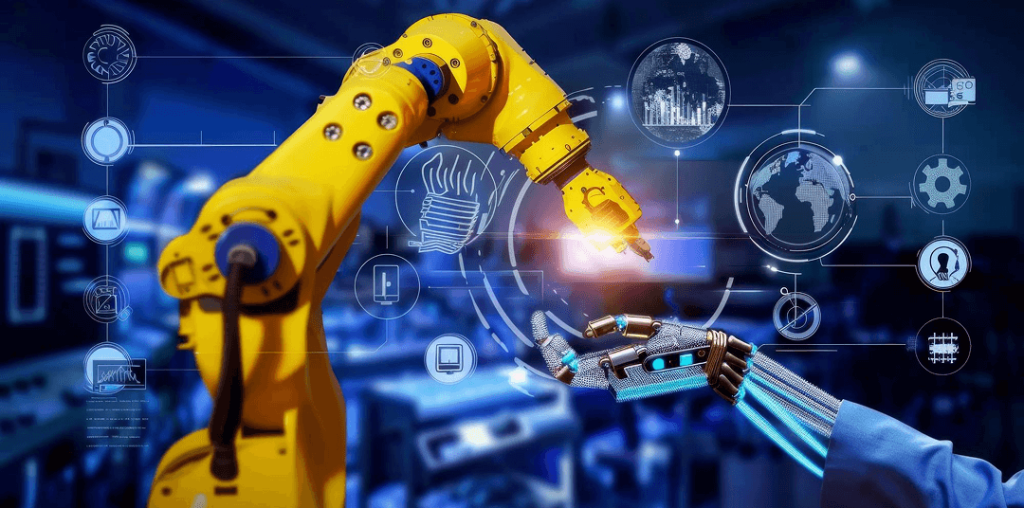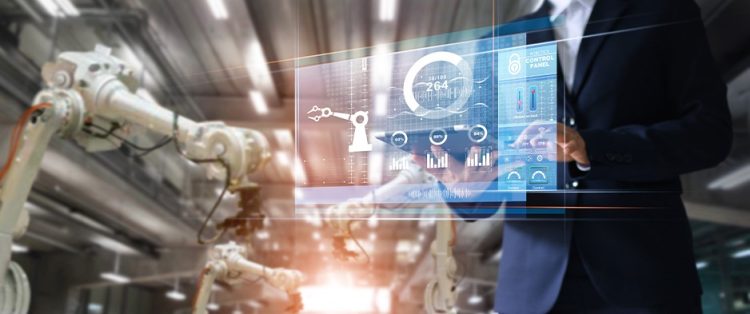1. Introduction
Intelligent manufacturing, a core element of Industry 4.0, represents a leap forward in the way products are designed, produced, and distributed. Combining cyber-physical systems, smart sensors, cloud computing, and advanced data analytics, intelligent manufacturing systems are poised to transform traditional manufacturing practices. Not only does intelligent manufacturing improve product quality, but it also significantly shortens production cycles, enabling faster responses to market demands, enhancing flexibility, and boosting competitive advantage.
With these technological advances, manufacturers are now able to produce products with higher precision, fewer defects, and lower costs. The implementation of robotics and automation in production lines, combined with real-time data monitoring and predictive maintenance, ensures that manufacturing processes are both efficient and resilient.
This article investigates the multifaceted benefits of intelligent manufacturing, its impact on production timelines, and how it enhances the quality of goods. It also delves into the future of manufacturing and the role of emerging technologies in shaping the next industrial revolution.
2. The Evolution of Manufacturing: From Traditional to Intelligent Systems
2.1 Traditional Manufacturing vs. Intelligent Manufacturing
Traditional manufacturing processes, while effective, often rely on manual labor, rigid production lines, and limited data feedback. The processes are typically isolated, lacking real-time monitoring or the ability to adapt quickly to changes in demand or unforeseen issues.
In contrast, intelligent manufacturing systems leverage connected devices, automation, and real-time data analytics to optimize each stage of production. This transition is a result of advancements in IoT (Internet of Things), cloud computing, and AI, all of which enable systems to continuously learn from operational data and improve performance without human intervention.
2.2 Key Components of Intelligent Manufacturing
Several technologies play pivotal roles in enabling intelligent manufacturing. These include:
- Automation & Robotics: Robots perform complex tasks with high precision, reducing human error, improving consistency, and allowing 24/7 production.
- Artificial Intelligence (AI): AI algorithms analyze large datasets to predict trends, optimize processes, and adjust production methods in real-time.
- IoT Sensors: Embedded sensors monitor machine health, inventory levels, and production status, providing continuous feedback to optimize operations.
- Additive Manufacturing (3D Printing): Enables customized production and the rapid prototyping of new products with less material waste.
- Big Data & Analytics: Data from multiple sources is collected and analyzed to make informed decisions, forecast demand, and fine-tune production processes.
3. Enhancing Product Quality Through Intelligent Manufacturing
3.1 Precision and Consistency
One of the most notable advantages of intelligent manufacturing is its ability to improve product quality. Robots, for instance, perform tasks like welding, assembly, and painting with unmatched accuracy, reducing variability in the final product. Automated inspection systems ensure that every product meets strict quality standards, detecting defects in real-time and removing defective items before they reach consumers.
In the aerospace industry, for example, components must meet exacting standards for safety and performance. Intelligent manufacturing ensures that each part is produced with precision, minimizing the risk of faults or failures during operation.
3.2 Real-Time Monitoring and Quality Control
With smart manufacturing systems, real-time data collection from sensors allows manufacturers to track the quality of every component as it moves through production. Predictive quality control tools assess data trends to identify potential defects before they occur, allowing manufacturers to take corrective action before problems arise.
For example, in electronics manufacturing, real-time monitoring can ensure that components such as microchips are produced without defects by constantly analyzing manufacturing conditions like temperature, humidity, and machine vibration. This proactive approach to quality control helps maintain high standards and reduces waste.
3.3 Customization and Flexibility
Another benefit of intelligent manufacturing is the ability to produce customized products more efficiently. Using 3D printing and digital twins, manufacturers can create personalized items tailored to individual customer specifications. Whether it’s specialized medical devices or custom car parts, intelligent manufacturing enables the production of low-volume, high-quality goods at a faster pace.
This flexibility is especially useful in industries like consumer electronics and fashion, where customers increasingly demand personalized products. Smart systems can quickly adapt to changes in design or customer preferences, allowing for more agile production workflows.

4. Shortening Production Cycles in Intelligent Manufacturing
4.1 Streamlining Processes with Automation
The core of intelligent manufacturing’s ability to shorten production cycles lies in its use of automation. By replacing manual labor with robotic systems and automated production lines, manufacturers can increase the speed of assembly, packaging, and shipping. Robots perform repetitive tasks with consistent speed and precision, reducing cycle times and boosting throughput.
For example, in automotive manufacturing, robots can handle assembly line tasks such as fitting windshields, welding body parts, and testing engines. This automation ensures that production lines run efficiently with minimal downtime, allowing manufacturers to meet customer demands faster and more efficiently.
4.2 Real-Time Adaptation and Flexibility
Another key factor in shortening production cycles is the ability of intelligent manufacturing systems to adapt in real-time to changes. The integration of AI algorithms allows the system to make instant adjustments based on real-time data inputs such as raw material availability, machine performance, or shifts in demand.
This adaptability reduces bottlenecks in production, minimizing delays. In the electronics industry, for example, production cycles can be shortened by optimizing assembly lines based on real-time feedback, ensuring that the most efficient process is always in play. The result is quicker turnaround times, allowing manufacturers to respond more quickly to market shifts.
4.3 Reducing Downtime with Predictive Maintenance
Predictive maintenance, powered by IoT sensors and machine learning, plays a crucial role in reducing downtime, which is often a major contributor to extended production cycles. Sensors embedded in machines monitor performance data and predict when maintenance is needed, preventing unplanned breakdowns.
For example, in a manufacturing plant, robots and machines equipped with predictive maintenance tools can signal when they need repairs or adjustments before they break down. By proactively addressing maintenance needs, production delays are minimized, and downtime is reduced, leading to shorter production cycles.
5. The Economic Impact of Intelligent Manufacturing
5.1 Cost Efficiency and Profitability
The combination of improved product quality and shorter production cycles leads to significant cost savings for manufacturers. Reduced material waste, lower labor costs, and increased operational efficiency are all direct outcomes of intelligent manufacturing practices. Additionally, by optimizing production schedules, companies can reduce overhead costs and increase output, directly impacting profitability.
For instance, automated warehouse systems significantly reduce labor costs associated with storage and order fulfillment, while AI-driven demand forecasting ensures that inventory levels are always optimized, reducing unnecessary stock and storage costs.
5.2 Competitive Advantage in Global Markets
The adoption of intelligent manufacturing offers manufacturers a competitive edge in a globalized marketplace. By reducing production costs, improving product quality, and shortening lead times, companies can offer better value to customers. This enhanced efficiency enables manufacturers to respond quickly to changes in market demand, ensuring they stay ahead of competitors who rely on traditional, slower production methods.
For example, in consumer electronics, where time-to-market is crucial, intelligent manufacturing enables companies to bring new products to market faster than competitors, capitalizing on emerging trends and consumer preferences.
5.3 The Future of Intelligent Manufacturing
As artificial intelligence, machine learning, and robotics continue to evolve, the potential for intelligent manufacturing to drive further economic growth is vast. Manufacturers will continue to push the boundaries of what’s possible, exploring new ways to reduce costs, enhance product customization, and streamline production. Additionally, the integration of 5G networks and cloud computing will further improve communication and data analysis across global supply chains, enabling even more efficient and responsive production systems.
6. Conclusion
Intelligent manufacturing has become a pivotal force in modern industry, offering a powerful combination of increased product quality and shortened production cycles. As technology continues to advance, the synergy of automation, AI, robotics, and real-time data analytics will further redefine the manufacturing landscape, driving greater productivity, economic growth, and market competitiveness.
The move towards smart factories and industry 4.0 offers unparalleled advantages, including cost reduction, faster production timelines, and customization capabilities. As businesses around the world embrace these innovations, intelligent manufacturing will play an increasingly important role in shaping the future of global industries, paving the way for a new era of efficiency and growth.







































